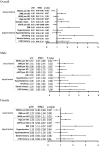Prognostic Value of Arm Circumference for Cardiac Damage and Major Adverse Cardiovascular Events: A Friend or a Foe? A 2-Year Follow-Up in the Northern Shanghai Study
- PMID: 35811737
- PMCID: PMC9260245
- DOI: 10.3389/fcvm.2022.816011
Prognostic Value of Arm Circumference for Cardiac Damage and Major Adverse Cardiovascular Events: A Friend or a Foe? A 2-Year Follow-Up in the Northern Shanghai Study
Abstract
Background: The high prevalence of cardiovascular diseases globally causes a great social burden and much individual suffering. The effective recognition of high-risk subjects is critical for primary prevention in the general population. In the elderly cohort, anthropometric measurements may have different prognostic values. Our study aimed to find convincing anthropometric measures to supplement conventional risk factors for major adverse cardiovascular events (MACEs) in the elderly cohort.
Materials and methods: A total of 1,576 elderly participants (44.5% male, aged 72.0 ± 6.0 years) recruited into the Northern Shanghai Study (2014-2015) were followed up between 2016 and 2017. Following the standard guideline for cardiovascular risk evaluation, all conventional cardiovascular risk factors were assessed. The body measures were made up of body weight, body height, hip circumference, waist circumference, and middle-upper arm circumference (MUAC). Organ damage (OD) markers for cardiac, vascular, and renal diseases will be evaluated by the standardized methods.
Results: After the average 571 (±135) days of follow-up, a total of 90 MACEs (5.7%) occurred, i.e., 13 non-fatal myocardial infarction, 68 non-fatal stroke, and 9 cardiovascular deaths. Univariable COX survival analysis revealed that only MUAC could validly predict MACEs among anthropometric characters [adjusted hazard ratio (HR) 0.89; 95% confidence interval (CI) 0.82-0.96]. In Kaplan-Meier analysis, the group of high MUAC showed the lowest MACE risk (log-rank p = 0.01). Based on OD analysis, MUAC was independently linked to higher risk of left ventricular hypertrophy (LVH) in women and left ventricular diastolic dysfunction (LVDD) in both men and women. In adjusted COX analysis, only MUAC indicated statistical significance, but all other anthropometric parameters such as BMI, waist circumference, and waist-to-hip ratio (WHR) did not indicate significance. The higher level of MUAC remained a protective factor in fully adjusted models (HR: 0.73; 95% CI: 0.59-0.91), with p-values markedly significant in men (HR: 0.69; 95% CI: 0.49-0.97) and marginally significant in women (HR: 0.0.77; 95% CI: 0.59-1.01). After considering all factors (i.e., cardiovascular risk factors, MUAC, BMI, and WHR), the fully adjusted COX regression analysis demonstrated that the increased MUAC level was linked to decreased MACE risk in both men (HR: 0.57; 95% CI: 0.37-0.88) and women (aHR: 0.64; 95% CI: 0.46-0.93).
Conclusion: Despite being associated with a higher rate of cardiac damage, higher MUAC independently and significantly conferred protection against the MACE, in the elderly cohort.
Keywords: Chinese; anthropometric measurement; cardiovascular; elderly; health care; target organ damage.
Copyright © 2022 Zheng, Zhang, Ren, Meng, Tang, Zhao, Chi, Xiong, Teliewubai, Maimaitiaili, Xu and Zhang.
Conflict of interest statement
The authors declare that the research was conducted in the absence of any commercial or financial relationships that could be construed as a potential conflict of interest.
Figures



References
-
- Naghavi M, Abajobir AA, Abbafati C, Abd-Allah F, Abera SF, et al. Global, regional, and national age-sex specific mortality for 264 causes of death, 1980–2016: a systematic analysis for the global burden of disease study 2016. Lancet. (2017) 390:1151–210. 10.1016/S0140-6736(17)32152-9 - DOI - PMC - PubMed
LinkOut - more resources
Full Text Sources

